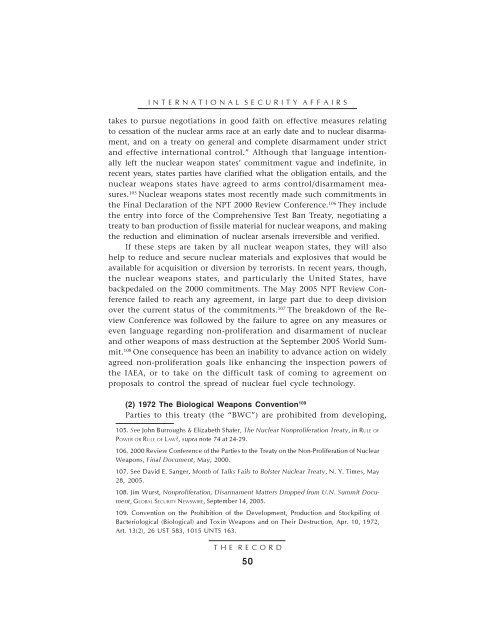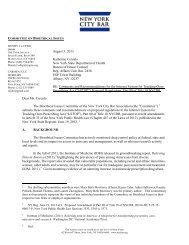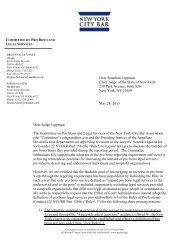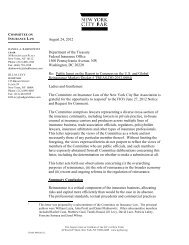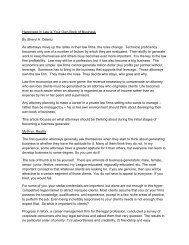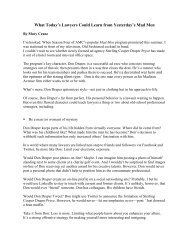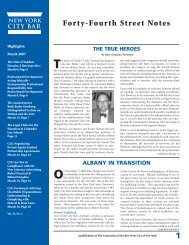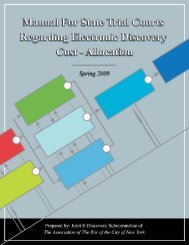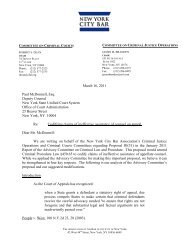2007 Issue 1 - New York City Bar Association
2007 Issue 1 - New York City Bar Association
2007 Issue 1 - New York City Bar Association
You also want an ePaper? Increase the reach of your titles
YUMPU automatically turns print PDFs into web optimized ePapers that Google loves.
I N T E R N A T I O N A L S E C U R I T Y A F F A I R S<br />
takes to pursue negotiations in good faith on effective measures relating<br />
to cessation of the nuclear arms race at an early date and to nuclear disarmament,<br />
and on a treaty on general and complete disarmament under strict<br />
and effective international control.” Although that language intentionally<br />
left the nuclear weapon states’ commitment vague and indefinite, in<br />
recent years, states parties have clarified what the obligation entails, and the<br />
nuclear weapons states have agreed to arms control/disarmament measures.<br />
105 Nuclear weapons states most recently made such commitments in<br />
the Final Declaration of the NPT 2000 Review Conference. 106 They include<br />
the entry into force of the Comprehensive Test Ban Treaty, negotiating a<br />
treaty to ban production of fissile material for nuclear weapons, and making<br />
the reduction and elimination of nuclear arsenals irreversible and verified.<br />
If these steps are taken by all nuclear weapon states, they will also<br />
help to reduce and secure nuclear materials and explosives that would be<br />
available for acquisition or diversion by terrorists. In recent years, though,<br />
the nuclear weapons states, and particularly the United States, have<br />
backpedaled on the 2000 commitments. The May 2005 NPT Review Conference<br />
failed to reach any agreement, in large part due to deep division<br />
over the current status of the commitments. 107 The breakdown of the Review<br />
Conference was followed by the failure to agree on any measures or<br />
even language regarding non-proliferation and disarmament of nuclear<br />
and other weapons of mass destruction at the September 2005 World Summit.<br />
108 One consequence has been an inability to advance action on widely<br />
agreed non-proliferation goals like enhancing the inspection powers of<br />
the IAEA, or to take on the difficult task of coming to agreement on<br />
proposals to control the spread of nuclear fuel cycle technology.<br />
(2) 1972 The Biological Weapons Convention 109<br />
Parties to this treaty (the “BWC”) are prohibited from developing,<br />
105. See John Burroughs & Elizabeth Shafer, The Nuclear Nonproliferation Treaty, in RULE OF<br />
POWER OR RULE OF LAW, supra note 74 at 24-29.<br />
106. 2000 Review Conference of the Parties to the Treaty on the Non-Proliferation of Nuclear<br />
Weapons, Final Document, May, 2000.<br />
107. See David E. Sanger, Month of Talks Fails to Bolster Nuclear Treaty, N. Y. Times, May<br />
28, 2005.<br />
108. Jim Wurst, Nonproliferation, Disarmament Matters Dropped from U.N. Summit Document,<br />
GLOBAL SECURITY NEWSWIRE, September 14, 2005.<br />
109. Convention on the Prohibition of the Development, Production and Stockpiling of<br />
Bacteriological (Biological) and Toxin Weapons and on Their Destruction, Apr. 10, 1972,<br />
Art. 13(2), 26 UST 583, 1015 UNTS 163.<br />
T H E R E C O R D<br />
50


